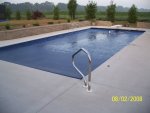bk406 said:
chem geek said:
At 2 inches that is a weight of 711 pounds over a 16' x 32' area or 1.4 pounds per square foot which isn't very much. .
Can you show your work?
I made a mistake since I forgot to convert cubic feet into gallons before using 8.33 pounds per gallon. So your number is correct and for my example 2 inches is a weight of 5317 gallons or 10.4 pounds per square foot (I've edited/corrected my earlier post). That does sound like a lot more, but apparently the buoyancy effect must help out a lot. So if your water level is too low, then the cover won't hold much water at all without having problems. However, with a sufficient water level and enough slack, it won't be a problem.
Obviously, if the slack were 4" so 2" on each side then this clearly works with no stress whatsoever as the cover is in a U shape flat over the pool water and then turning up at the sides 90 degrees. The question is what happens with the more usual slack of around 1-1/2 to 2" (for an undertrack like mine; an overtrack would have more slack so that the cover was mostly on the water). The cover will go at a diagonal to the water and then be flat. In my own pool, I'd say that the cover is "on" the water within 2 feet from each edge, but with extra slack (i.e. not taut). If taut, then perhaps it's around 1 foot from each edge. So the question is how much the cover level drops when 2" of water is on top. The answer is it drops such that the pool water underneath on the sides rises to meet the 2" higher level. Assuming the 16' width with 1' on each side not touching the water initially, this is found as follows:
If "x" is the number of inches the water in the pool drops due to the cover with water on top of it while "y" is the rise in the pool water level at the sides where the cover is off the pool, then
x*14 = y*2 since the water displaced in the middle must equal that which rose at the sides
Old + 2 - x = Old + y since the level of water on the cover must equal the level at the sides
x*14 = (2-x)*2 so 16*x = 2 so x = 1/8" which means that y = 2" - 1/8" = 1-7/8"
So even ignoring the angled entry of the cover to the pool, a drop of 1/8" would at most require a slack of 1/4". So the felt weight of the water on the cover will only be that amount where the cover is not touching the water so only at some inches near the side and even then there won't be 2" of water on top since the cover will angle upwards there. I think one doesn't get serious tension until one uses up the slack completely.
By the way, when one walks out onto the cover it becomes fairly taught in the width area where you are walking, but that is because the displaced water is rising evenly throughout the pool (except where you are stepping) while your weight displacement is very localized so you use up much of the slack where you step and miss out on the overall buoyancy effect. This is not the case for rain or snow on the cover assuming it is fairly evenly distributed.



